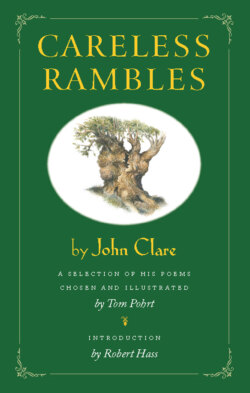Читать книгу Careless Rambles by John Clare - John Clare - Страница 6
На сайте Литреса книга снята с продажи.
ОглавлениеPREFACE
I stumbled on the name John Clare a few years ago in a book review. It was in the opening pages of Christopher Hitchins book God Is Not Great: “If you read John Clare’s imperishable rural poems you will catch the music of what I mean to convey.” Imperishable rural poems. Reading this I felt an immediate and overwhelming impulse to follow the name John Clare. I had heard of this poet. His name was imbedded in my subconscious, but it was not until later that I recalled the sing-song poem Little Trotty Wagtail.
Coming across the Hitchens review and reading that particular sentence was like catching a side-long peripheral glance of a bird in flight, that just as easily could have been missed. I took to my computer to research what I could find of Clare. Before the night was out I felt I knew the direction I was headed in for the next year or so.
The path’s even covered with insects—each sort Flock by, crowds in the smiles of the morning to sport: There’s the cricket in brown and his cousin in green, The grasshopper dancing, and o’er them is seen The ladybird dressed like a hunter in red, Creeping out from the blossom with whom she went bed. So good little girls, now disturb not their play And you, Freddy, stop till they hop far away, For to kill them in sport, as many folks will, And call it a pastime ’tis cruel and ill, As their lives are as sweet of enjoyment as ours And they dote like yourselves upon sunshine and flowers.
Like a Jain monk gently sweeping the floor for insects, so as not to accidently step on them, Clare penned these lines with a deep compassion to identify with the natural world. This empathy with insects, plants and animals is one of the things endearing to Clare’s poetry. (In our own household my young daughter and I bottle the stray ant, spider and bee, to remove outdoors.)
The above poem, The Holiday Walk, begins;
Come, Eliza and Anna, lay by top and ball And, friendly boy, throw away cart and toys all, Look about for your hats and dispense with your play, We’ll seek for the fields and be happy today.
Here, Clare is taking his own children (Eliza, Anna & Freddy) out on a nature walk, but he also taking us along on the ramble, a walk as well perhaps into his own childhood past. His description of the landscape reads as if before the Enclosure Acts, when there were still plenty of open fields and common land around Helpston and the surrounding parishes. From vast sky-scape description of “hawks sailing proud as the clouds” to the flea-glass/microscope intimacy of ants “nimbling about in the grass”, we tag along on this happy sojourn.
At heart the poems of John Clare also take me back to when I was much younger, to hot summer days spent wandering fields, inland lakes and woods of my northern Michigan, “Nick Adams” country. Our family spent many summers vacationing in this northern landscape. My parents owned property in an old Anishinabe Indian community situated along a bluff overlooking Lake Michigan. The local farmers were a mix of Irish, English, German, and later Polish. By the early 20th century the logging industry that long defined the economy here had mostly disappeared. Few descendants of the original inhabitants remain. But not long ago an older generation would often leave a wood chair propped against their front door when away from the house. You would see this from a distance and save yourself the walk. A lost civilized touch.
Red and Jack pine, birch, box elder, poplar, maples, Doug fir, the long lived white cedar, various oaks, beech, and elm along with an abundance of nut bearing trees make up the surrounding forest. The majestic northern white pine (Weymouth pine in Britain) is also found in these woods. I had my favorite climbing trees, a number of old oaks, and an ancient pine that still stands. There were a pair of magnificent elms that grew together in the middle of a field between the bluff and lake. Raspberry bushes surrounded these huge trees. They appeared untouched by Dutch-elm disease, that was responsible for the loss of the big elms that lined the street I grew up on in the city of Flint. These healthy trees were later cut down, for reasons I still can not fathom.
My father was keen on birds and delighted in identifying their calls. This interest extended to his knowledge in identifying trees and the grain in their wood. We had our secret spot for finding elderberries, snapping off bunches to take home, washing and stripping berries from the branches, leaving finger tips stained purple, for pies. We often collected black walnuts, a time-intensive passion with a meager return when we counted the number of eatable nuts retrieved.
I picked mushrooms from deep in the woods and we all hunted for raspberries and blueberries. We kept an open-eye when fresh bear scat was found in the low growing bush. I spent many long hours in solitary observation of nature, for pure enjoyment.
The idea of an illustrated collection of Clare simply came about as I was reading his poems. The superb John Clare: A Biography by Jonathan Bate was also an inspiration. A handful of my pen/ink sketches appeared in The John Clare Society Journal in 2009.
There is a wanderlust and a rambling sense of discovery in Clare’s poetry, that I wanted to convey with this collection. Clare was such a prolific poet it could not be helped that a number of excellent poems would have to be left out. I picked the poems I liked. This selection is my own.
Tom Pohrt 20th October, 2011
